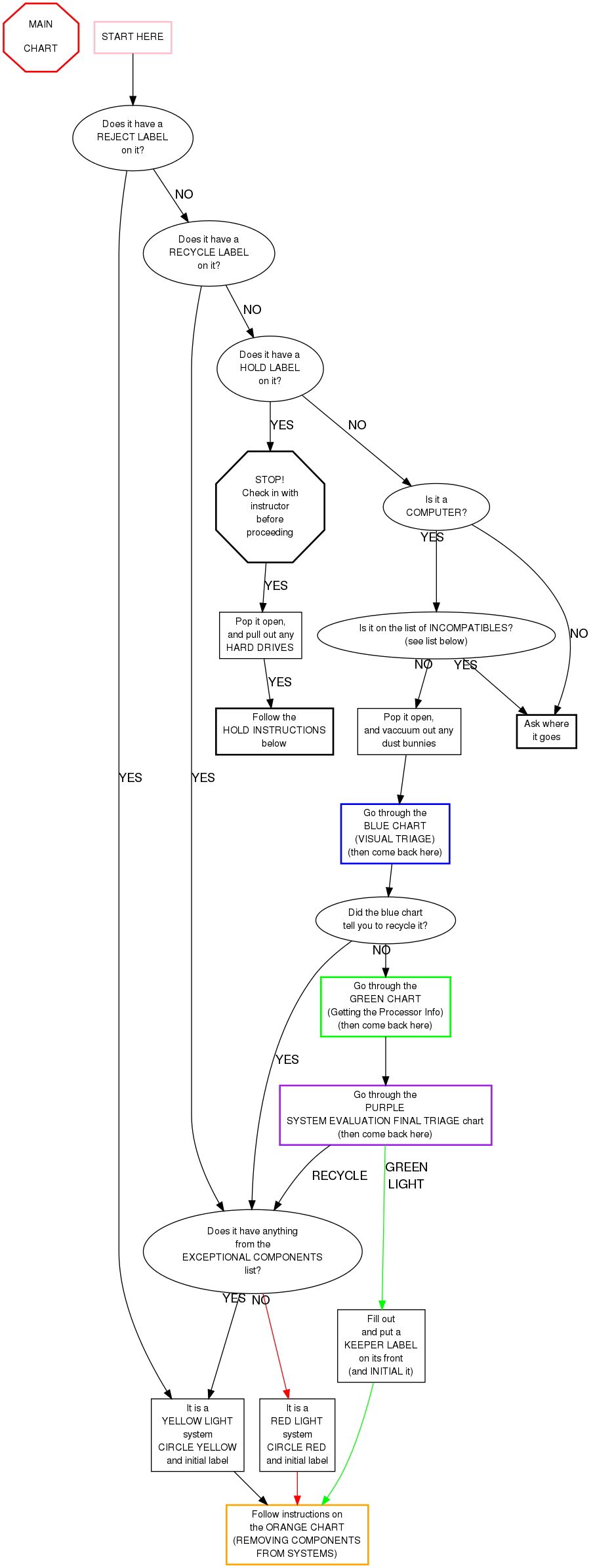Difference between revisions of "System Evaluation Overview"
Jump to navigation
Jump to search

m (phase 3 of spanish) |
m (→MAIN Chart: corrections to spanish version) |
||
| Line 40: | Line 40: | ||
label_es="¿Está circulado\n''RED LIGHT''\no\n''YELLOW LIGHT''?"] | label_es="¿Está circulado\n''RED LIGHT''\no\n''YELLOW LIGHT''?"] | ||
incompatible [label="Is it on the list\nof INCOMPATIBLES?\n(see list below)", | incompatible [label="Is it on the list\nof INCOMPATIBLES?\n(see list below)", | ||
| − | + | label_es="¿Está esto en la\nlista de ''INCOMPATIBLES''?\n(checar en la parte inferior)"] | |
labelit [label="Fill out\nand put a\nKEEPER LABEL\non its front\n(and INITIAL it)", | labelit [label="Fill out\nand put a\nKEEPER LABEL\non its front\n(and INITIAL it)", | ||
label_es="Completar y pegar\n la ''KEEPER LABEL''\nen la parte frontal\n(y escribir sus\nINICIALES)", | label_es="Completar y pegar\n la ''KEEPER LABEL''\nen la parte frontal\n(y escribir sus\nINICIALES)", | ||
| Line 80: | Line 80: | ||
recycle_label -> rejected [label="NO"] | recycle_label -> rejected [label="NO"] | ||
| − | recycle_label -> circled [label="YES"] | + | recycle_label -> circled [label="YES", label_es="SI"] |
rejected -> hold_label [label="NO"] | rejected -> hold_label [label="NO"] | ||
| − | rejected -> yellow [label="YES"] | + | rejected -> yellow [label="YES", label_es="SI"] |
circled -> initial [label="RED or\nYELLOW\nCIRCLED"] | circled -> initial [label="RED or\nYELLOW\nCIRCLED"] | ||
circled -> exceptional [label="NOTHING\nCIRCLED"] | circled -> exceptional [label="NOTHING\nCIRCLED"] | ||
| − | hold_label -> check_in [label="YES"] | + | hold_label -> check_in [label="YES", label_es="SI"] |
hold_label -> rack_mount [label="NO"] | hold_label -> rack_mount [label="NO"] | ||
| − | rack_mount -> check_in [label="YES"] | + | rack_mount -> check_in [label="YES", label_es="SI"] |
rack_mount -> computer [label="NO"] | rack_mount -> computer [label="NO"] | ||
| − | exceptional -> yellow [taillabel="YES"] | + | exceptional -> yellow [taillabel="YES", taillabel_es="SI"] |
exceptional -> red [taillabel="NO", color="red"] | exceptional -> red [taillabel="NO", color="red"] | ||
| Line 104: | Line 104: | ||
computer -> askwhere [label="NO"] | computer -> askwhere [label="NO"] | ||
| − | computer -> mac [taillabel="YES"] | + | computer -> mac [taillabel="YES", taillabel_es="SI"] |
mac -> incompatible [taillabel="NO"] | mac -> incompatible [taillabel="NO"] | ||
| − | mac -> mac_chart [taillabel="YES"] | + | mac -> mac_chart [taillabel="YES", taillabel_es="SI"] |
| − | incompatible -> askwhere [taillabel="YES"] | + | incompatible -> askwhere [taillabel="YES", taillabel_es="SI"] |
incompatible -> vaccuum [taillabel="NO"] | incompatible -> vaccuum [taillabel="NO"] | ||
vaccuum -> visual | vaccuum -> visual | ||
| Line 115: | Line 115: | ||
visual -> whichway | visual -> whichway | ||
| − | whichway -> exceptional [label="YES"] | + | whichway -> exceptional [label="YES", label_es="SI"] |
whichway -> trytopost [taillabel="NO"] | whichway -> trytopost [taillabel="NO"] | ||
Revision as of 18:20, 21 September 2010
MAIN Chart

Filling out a KEEPER label
- Count the DDR slots and circle the correct number.
- For AMD chips:
- Circle AMD in the "Proc Type" section
- Write the processor model number in the "Processor Information" area
- For Intel and other chips:
- Circle the processor type (or write next to "Other")
- Write the processor speed in the "Processor Information" area
- If there are any SATA connectors on the motherboard circle the appropriate number
- If there are any IDE connectors on the motherboard circle the appropriate number
- If the system can take more than one processor, check the Multi Proc Capable box
- If the system has a dual core processor, check the Dual Core box
- If the system did not POST successfully, check the Did not POST box
- If there are any PCIe slots, circle PCI-e
- If there is an AGP slot, circle AGP
- Remember to put your initials in the appropriate box
Incompatibles
NOTE: If a system has no brand name on it, then it is not on this incompatibles list.
- Amiga
- Apple, etc:
- Mac
- Radius
- PowerPC
- PowerComputing
- Umax Supermac
- Commodore
- DEC (Digital Equipment Corporation)
- Sun
- Silicon Graphics (SGI)
- Indy (they're blue)
- anything with the label RISC on it
- High Speed or Ultra Speed CD RW
- They must have a standard 5.25" rectangular faceplate and not be laptop-sized.
- A drive is only High Speed or Ultra Speed if it literally says "High Speed" or "Ultra Speed" to the right of the "Compact Disc" label.
- DVD Drive
- They must have a standard 5.25" rectangular faceplate and not be laptop-sized.
- Front side card readers, only if it includes a cable
- Gigabit ethernet card (Network Card marked 1000)
- Wireless card
- Power supply with a SATA connector
- Molex to SATA power supply adapter
- Molex to 6-pin power supply adapter
- Motherboard with SATA connector(s)
- A really cool case that some geeky kid would drool over
